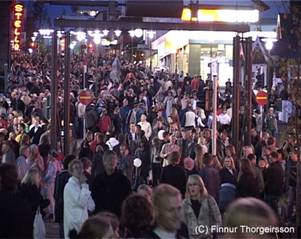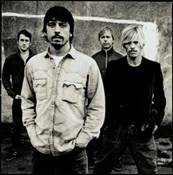About Iceland
Icelandic Geology
The History of Iceland
Höfn í Hornafirði
Culture and Music
 Some people know something about Iceland, (like you) but not everybody… so just to avoid any misunderstanding; no, we don't live in igloos and whale meat is not the most common food : ) Maybe you dont want to come if you hear more about the food, but it´s not as bad as it sounds. We eat pretty normal food, and a lot of fish of course. Then you can have hákarl, which is putrefied shark meat that has been buried for up to six months to ensure sufficient decomposition… and with that you'll have a sort of shot, called brennivín, but that is a traditional Icelandic brew. We will just tell you later about hrútspungar and svið… And actually, we dont eat much of this stuff we have been talking about, except the normal fish.
Some people know something about Iceland, (like you) but not everybody… so just to avoid any misunderstanding; no, we don't live in igloos and whale meat is not the most common food : ) Maybe you dont want to come if you hear more about the food, but it´s not as bad as it sounds. We eat pretty normal food, and a lot of fish of course. Then you can have hákarl, which is putrefied shark meat that has been buried for up to six months to ensure sufficient decomposition… and with that you'll have a sort of shot, called brennivín, but that is a traditional Icelandic brew. We will just tell you later about hrútspungar and svið… And actually, we dont eat much of this stuff we have been talking about, except the normal fish.
Many good books have been written in Iceland. The sagas are important sources material about life in Iceland during the first centuries. One of those writers was Snorri Sturluson, who has entertained and informed readers since the 12th century. Jónas Hallgrímsson (1807-1845) was also a very good writer. He wrote beautiful poems about our country and nature and made a lot of new words that we use in our language now. One of the most famous Icelandic writer of the 20th century is the Nobel Prize winner Halldór Kiljan Laxness. In addition a lot of autobiography books are written every year in Iceland which is very special.
Since these early beginnings of art in Iceland countless Icelandic artists; authors, poets, painters and sculptors have created a body of art larger than the relatively low population of the island would suggest. Novels, stories, short-stories, plays, poems, paintings, sculptures have been created that combine international influences with the unique spirit of Iceland in interesting works of art.
 There are a lot of museums here in Iceland, almost every single district has its own rural museum with its own local history and special atmosphere. We have a lot about the Vikings and other things from the past, and our landscape is of course one big work of art (made by God). Icelandic people believe in elves and trolls, the mountains are sometimes called names from the trolls who should have lived there long time ago. We have a lot of stories about those things in the nature and some people got that gift to see that kind of things.
There are a lot of museums here in Iceland, almost every single district has its own rural museum with its own local history and special atmosphere. We have a lot about the Vikings and other things from the past, and our landscape is of course one big work of art (made by God). Icelandic people believe in elves and trolls, the mountains are sometimes called names from the trolls who should have lived there long time ago. We have a lot of stories about those things in the nature and some people got that gift to see that kind of things.
Then we have theatres, cinemas, café, and in Reykjavík we have our two biggest shopping centres (called Kringlan and Smáralind) and in the inner city is the street Laugavegur with a lot of shops.
 The nightlife in Iceland is just fine. We have special days to celebrate, and the first weekend in August, called Verslunarmannahelgi, is something that teenagers celebrate the most. This is the weekend to go for a trip and have fun, because the Monday is free also. Then there are fireworks all over the country and people making out in every tent.
The nightlife in Iceland is just fine. We have special days to celebrate, and the first weekend in August, called Verslunarmannahelgi, is something that teenagers celebrate the most. This is the weekend to go for a trip and have fun, because the Monday is free also. Then there are fireworks all over the country and people making out in every tent.
Menningarnótt, or “culture night” is the night for Icelandic culture, also in August. Then the centre of Reykjavík is just full of people. Here in Höfn, we celebrate the lobster in Humarhátið every summer, the first weekend in July.
Near by the International Airport at Keflavík, is one of the places that foreigners know maybe better than Icelandic people do. It's the Blue Lagoon, a mineral-rich hot water from far beneath the earth forms the spectacular man-made lagoon, where a luxurious health spa has been developed in the rugged lava landscape. To go to the Blue Lagoon is absolutely necessary and unforgettable experience!
 Music is a large factor in Icelandic culture. We have many different kinds of music. We have bands, choirs and a lot more.
Music is a large factor in Icelandic culture. We have many different kinds of music. We have bands, choirs and a lot more.
Some Icelandic artists and bands have been popular in other countries. For example: Björk, Sigurrós, Emiliana Torrini, Quarashi, Múm, Mínus and Gus gus.
Björk is the most famous Icelandic person in the universe. She became famous for her original music, and her style, which is very special.
In Iceland are both “fresh” pop artists, and also the old ones, who have been in the music industry for 50 years. The youngest listeners are mostly into pop music, like Írafár and Í svörtum fötum. The lead singers of these two bands, Birgitta and Jónsi, have both represented Iceland in the Eurovision Song Contest.
We have an Icelandic Idol singing contest here, based on the same ideas as the American one. The judges in our Idol are well known musicians here in Iceland.
In the beginning of every year, there is a musical contest for bands formed by teenagers who want to be known. It's called Músíktilraunir. Some of the most popular Icelandic musicians have begun their career there.
 There is a singing contest every year for all colleges in the country. It's called Söngkeppni framhaldsskólanna. In March/April, every college sends a representative to this contest, and like in Músíktilraunir, some Icelandic musicians became well known there. There is also such a thing for high schools, and it's called Samfés.
There is a singing contest every year for all colleges in the country. It's called Söngkeppni framhaldsskólanna. In March/April, every college sends a representative to this contest, and like in Músíktilraunir, some Icelandic musicians became well known there. There is also such a thing for high schools, and it's called Samfés.
In Iceland we have many choirs. Here in Höfn we have 4-5. There are one for children, women and men and a mixed one and also one for pensioner. We also have many brass bands here in Iceland. Sara Eik and Tjörvi are in the brass band in Höfn.
In the last two years, Iceland has been becoming a popular place for famous bands t o hold concerts on. Last year there were many bands which performed here. Like Metallica, Placebo, Incubus, KoRn, Kraftwerk, Scooter, P!nk, Prodigy, Deep purp
o hold concerts on. Last year there were many bands which performed here. Like Metallica, Placebo, Incubus, KoRn, Kraftwerk, Scooter, P!nk, Prodigy, Deep purp le, Pixies, just to name a few. This year we are expecting: Iron Maiden, Velvet Revolver, Foo fighters (they were also here in 2003), Queens of the stone age and Duran Duran, but these are the only ones that have been announced, so there is a possibility of more bands coming.
le, Pixies, just to name a few. This year we are expecting: Iron Maiden, Velvet Revolver, Foo fighters (they were also here in 2003), Queens of the stone age and Duran Duran, but these are the only ones that have been announced, so there is a possibility of more bands coming.
Of course you don't have to be famous to sing or make any kind of music, we do that at many occasions, for example on parties.
Written by: Birna Jódís and Sara Eik